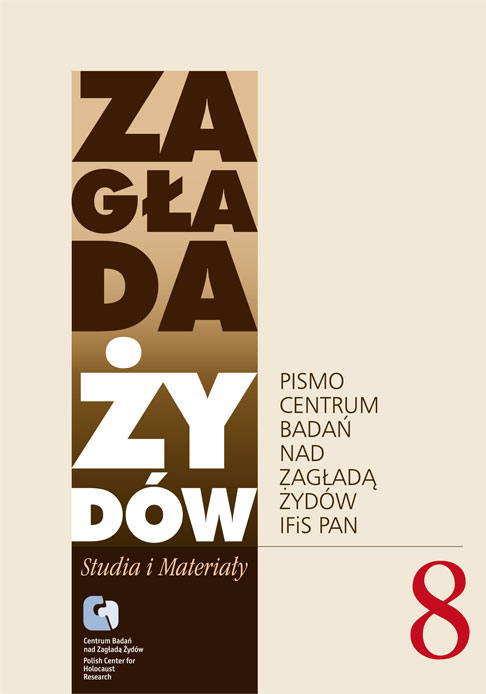Odmienne sylwetki przybyłych do Szwecji więźniów pochodzenia żydowskiego i nieżydowskiego, ocalałych z obozów koncentracyjnych na ziemiach polskich
Zagłada Żydów. Studia i Materiały, Nr 8 (2012), Strony: 419-429
Data zgłoszenia: 2020-12-06Data publikacji: 2012-12-02
 https://doi.org/10.32927/zzsim.698
https://doi.org/10.32927/zzsim.698
Abstrakt
Survivors from Nazi concentration camps, who were brought to Sweden as refugees during the last month of the Second World War and during the summer that followed, were often required to supply information about personal details to the authorities. Much of the information was later stored in written form in the Swedish National Archives. Antisemitism among the refugees and enmity between the Jewish and non-Jewish Polish refugees caused the authorities to include their ethnic or religious affiliation in many records and documents. Using mainly two collections from the Swedish National Archives it is shown that substantial differences existed between Jewish and non-Jewish Polish refugees with respect to their age, education and the length of their war experiences. These differences, in addition to the existing socio-geographic, demographic, cultural and ethnic differences led to inevitable clashes between the two groups. The Swedish authorities who first regarded all refugees of Polish citizenship as one national group had to revise this attitude gradually during the administration of the refugees
Słowa kluczowe
ocalali z Zagłady , Szwecja , stosunki polsko-żydowskie
Licencja
Prawa autorskie (c) 2012 Autor&"Zagłada Żydów. Studia i Materiały"

Utwór dostępny jest na licencji Creative Commons Uznanie autorstwa 4.0 Międzynarodowe.
https://creativecommons.org/licenses/by/4.0
Czasopismo publikowane jest w standardzie Diamond Open Access na licencji CC-BY-4.0 Deed - Uznanie autorstwa 4.0 Międzynarodowa - Creative Commons
Podobne artykuły
- Renata Piątkowska, Muzeum Żydowskie i Centrum Tolerancji w Moskwie , Zagłada Żydów. Studia i Materiały: Nr 9 (2013)
- Zuzanna Schnepf-Kołacz, Losy pracowników niemieckiej gadzinówki „Nowy Kurier Warszawski” w świetle powojennych procesów z dekretu sierpniowego , Zagłada Żydów. Studia i Materiały: Nr 2 (2006)
- Adam Sitarek, „Nie myśl, że to pisze obłąkany”. Listy rabina z Grabowa i jego misja informowania o Zagładzie , Zagłada Żydów. Studia i Materiały: Nr 15 (2019)
- Piotr Rypson, Album rysunków Teofili Langnas-Reich w Archiwum Ringelbluma , Zagłada Żydów. Studia i Materiały: Nr 18 (2022)
- Martyna Grądzka-Rejak, „Od dłuższego czasu straciłem wszelki kontakt z żydami i żydostwem”. Neofici w okupowanym Krakowie w świetle materiałów Archiwum Kurii Metropolitalnej w Krakowie , Zagłada Żydów. Studia i Materiały: Nr 13 (2017)
- Dagmara Swałtek, Listy Gusty Ehrlich , Zagłada Żydów. Studia i Materiały: Nr 5 (2009)
- Jacek Leociak, Cenzor na straży Kościoła. Ocenzurowany pamiętnik Krystyny Modrzewskiej , Zagłada Żydów. Studia i Materiały: Nr 5 (2009)
- Zuzanna Schnepf-Kołacz, „Na ciechańskiej plebanii”. Historia ocalenia Zofii Trembskiej. Studium przypadku , Zagłada Żydów. Studia i Materiały: Nr 6 (2010)
- Johannes Breit, Lukas Meissel, Igraszki z symboliką Zagłady. Seria gier komputerowych „Wolfenstein” jako studium przypadku cyfrowych reprezentacji Zagłady , Zagłada Żydów. Studia i Materiały: Nr 17 (2021)
- Katarzyna Kuczyńska-Koschany, Zbyt mała, by być (tak) dużą. Rozważania na marginesie polskiej edycji krytycznej Mein Kampf Adolfa Hitlera , Zagłada Żydów. Studia i Materiały: Nr 17 (2021)
<< < 1 2 3 4 5 6 7 8 9 10 11 12 13 14 15 16 17 18 19 20 21 22 23 24 25 26 27 28 29 30 31 32 33 34 35 36 37 38 39 40 41 42 43 44 45 46 47 48 49 50 > >>
Możesz również Rozpocznij zaawansowane wyszukiwanie podobieństw dla tego artykułu.
 English
English
 Język Polski
Język Polski




